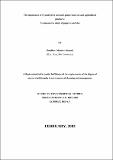| dc.description.abstract | This study assessed the community perceptions of the importance of wetland plants, particularly papyrus (Cyperus papyrus) and compared it with that of agricultural products, mainly rice (Oryza Sativa), in the Nyando River Wetlands, Kenya. The goal was to suggest better mechanisms for the sustainable management of the two resources and the wetlands. It was conducted among communities living in NRW area namely Nyando, Lower Nyakach and Kadibo Divisions of Kisumu and Nyando districts, from August 2000 to February 2001. Primary data was gathered using field observation, interviews, group discussions and questionnaires, administered to 120 randomly selected household heads. Secondary data was collected from published and unpublished materials. Results were analyzed using descriptive statistics. The community perceived papyrus to be important as a source of income, building material and production of handicrafts. Rice was viewed as a major source of family income and food. Majority, 65 (54.2%) respondents perceived rice to be more important, compared to 47 (39.2%) who perceived papyrus to be more important and 8 (6.7 %) who were undecided. This difference was significant (2 = 42.5, p = 0.05, df=2). There was no significant relationship between demographic factors and respondents choice of product with more value. However, there was a significant relationship between respondents’ choice and the physical characteristics of the wetland site in their locality (2 = 10.76, p = 0.05, df=4). The mean monthly income from rice was Ksh. 3106 and Ksh. 2414 from papyrus mat making. The differences in monthly mean incomes from the two enterprises were insignificant [F. (6, 79) =0.651, P= 0.05]. The study concluded that both papyrus and rice were important for the socio-economic development of the community. However, unchecked harvesting of papyrus, fire outbreaks, poor farm management practices, lack of appropriate skills, limited financial resources, poorly developed infrastructure, marketing problems and land use and land ownership conflicts resulted in the mismanagement and degradation of the wetlands. To increase community incomes and strengthen wetland conservation, there is need to identify and promote sustainable uses of the wetlands based on community perceptions of the importance of the wetlands, raise their awareness of the importance of wetlands conservation by providing appropriate training, education, extension services, financial and technical assistance. The wetlands should be zoned for various land uses, community based organizations established and strengthened, co-ordination between stakeholders in wetlands use and management enhanced and a comprehensive wetland management policy developed. There is need to investigate the uses of other wetland resources, demonstrate their wise use, plan for their conservation and explore the possibilities of making Nyando River Wetlands a Ramsar Site. | en_US |

